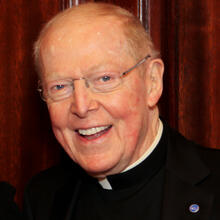Since its opening in 2005, the Museum of Biblical Art (MOBIA) in New York City has mounted first-rate exhibitions on biblical themes. Whether looking at the Bible through the eyes of Georges Rouault or Marc Chagall, or indulging in some fun with posters for religious films (“Reel Religion,” 2009), MOBIA has offered fresh and engaging perspectives on the most familiar of subjects.
The current show, on display until September 27, is another stand-out. “Scripture for the Eyes: Bible Illustration in Netherlandish Prints of the Sixteenth Century” offers 79 prints ranging from simpler woodcuts to elegant engravings. Produced in today’s Holland, Belgium and Luxembourg, this art emerged at a time of acute religious and political tension between Protestant and Catholic Reformers as well as between pro- and anti-imperial factions. Though it often transcends confessional divisions, at times it is discreetly—or overtly—partisan. The art ranges from a primary emphasis on religious function to interest in aesthetic achievement, not infrequently combining artistic ambition with didactic and devotional purposes.
In Lucas van Leyden’s “Return of the Prodigal Son” (c. 1510), engraving skill and moralistic fervor are gloriously united. The story is not only one of the finest parables in St. Luke’s Gospel, but was told again and again in school plays from the 13th to the 16th centuries in France, Germany and the Netherlands. Van Leyden’s sheet shows the repentant son and the welcoming father at the center of a grand vista that masterfully integrates the disdainful other son and his friends, the family home and towns near and distant, with a river in the middle distance to the right and the slaying of the fatted calf to the left.
Hendrick Goltzius is another notable artist of the period, and his “Adoration of the Magi” from “The Life of the Virgin” (1593-94) is an exercise in protean imitation of artistic styles from Raphael to Dürer. It is accomplished and deeply felt, with highly individualized figures and utter control of spatial composition. Walter S. Melion’s essay in the show’s catalogue comments that “it is often difficult, or well-nigh impossible, rigidly to demarcate confessional positions where biblical prints are concerned.” But confessional prejudices could certainly alter the reception of the work. Thus Goltzius’s “Adoration” could be interpreted by Protestant Reformers as suggesting their own long journey of challenging the institutional church in their search for Christ, while Counter-Reformers might see their own journey through persecution and dissension as ending in true devotion before the Savior. Similarly, in van Leyden’s “Return of the Prodigal,” Catholics might identify the father as an image of the institutional church welcoming back penitent Reformers, while Reformers could see him as God the Father accepting the contrition of a corrupt Roman Church. Goltzius himself, a life-long Catholic committed to ecumenical tolerance, could also be polemical but in an even-handed way, as is evident in two earlier engravings that address (and discourage) inter-confessional strife, “The Wisdom of Solomon” and “Dissent in the Church” (both c. 1578).
Theological differences were often more explicit. Pieter Nagel’s engraving “Man between the Old and New Covenant” (c. 1567) develops a theme deriving from the workshop of Lucas Cranach the Elder in the late 1520s. On the left are Moses with the tablets of the Law, Adam and Eve and a prophet accompanied by a skeleton; on the right John the Baptist pointing to the “Victory” of the risen Christ. Between them a distressed Everyman, wringing his hands, leans to the left but looks to the right. A literal pictorial translation of Luther’s theology of justification by faith alone, the print is, as the show’s catalogue points out, at once approbative, implicitly polemical and political.
Cornelis Cort’s engraving of the Annunciation surrounded by kings and prophets of the Hebrew Scripture, modeled after the fresco by Federico Zuccaro for the Chapel of the Annunciation in the Roman College of the Society of Jesus (1571), represents an understanding of the Incarnation that could be endorsed by Reformers and Counter-Reformers alike. But passages in the print extolling the Virgin’s motherhood and virtue seem to make it more sympathetic to Catholic Reformers. Jesuit influence also appears in lovely engravings by Hieronymus Wierix for two books of meditations on the gospels that were compiled by Jerome Nadal at the request of St. Ignatius of Loyola himself.
The overriding impression of this innovative art is of creative interaction between popular piety and an intense interest in newly available editions of the Bible, both St. Jerome’s Vulgate and vernacular texts. The question of salvation became highly personalized. Treatises on modes of meditation proliferated. Mystic theologians were prized, including the Flemish Jan van Ruysbroeck, who presented Christ the mediator as reconciling the foreign and discordant elements of human experience. The sufferings of Christ were given increasing emphasis, with frequent depictions of the Man of Sorrows. Christ in the Wine Press, another popular image, could easily be taken to extremes: in 1619 Hieronymus Wierix depicts Jesus bleeding profusely as God the Father operates the press with the cross as its beam and the dove of the Holy Spirit alighting at its top.
Many of the prints on view are more peaceful, but none lack drama. Whether your interest is the Bible or first-rate art, and especially if you think both are indispensable, get out your magnifying glass and make your way to MOBIA if you possibly can before this show closes on Sept. 27.
“Scripture for the Eyes” is organized by MOBIA and curated by Dr. James Clifton and Dr. Walter S. Melion. It is accompanied by a fully illustrated catalog, Scripture for the Eyes: Bible Illustration in Sixteenth Century Low Countries.









One of Henri Nouwen's best books is "Return of the Prodigal Son" which was inspired by the painting.